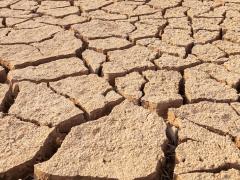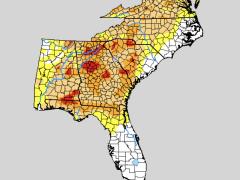Predicting Flash Drought
In its simplest form, flash drought is the rapid onset of drought. In contrast with conventional drought, which is mainly driven by lack of precipitation, flash drought usually includes abnormally high temperatures, winds, and/or incoming radiation that leads to abnormally high evapotranspiration (ET) rates. Flash droughts occur more often than perceived and can cause major agricultural losses if they are not predicted and detected in a timely manner. In fact, flash drought has recently developed in the Mid-Atlantic and Southeast regions. The prediction of flash droughts on subseasonal timescales is of critical importance for impact assessment, disaster mitigation, and loss prevention.

Researchers from the NOAA/NWS/NCEP Climate Prediction Center undertook a study to increase our understanding of the characteristics of flash drought events with the goal of further predicting the onset of such events on subseasonal timescales. The study, titled, “Flash Drought Characteristics Based on U.S. Drought Monitor” and published in the journal Atmosphere, defined a flash drought as an event with greater than or equal to two categories degradation in a four-week period based on the U.S. Drought Monitor.
The research team analyzed the conditions and evolution of five selected flash droughts using North American Land Data Assimilation System-2 (NLDAS-2) data. NLDAS-2, a collaboration between NASA, NOAA, and others, are land-surface model (LSM) datasets from the best available observations and model outputs to support modeling activities. The researchers selected the following flash droughts to study: 2000 Southern US, 2003 Midwest, 2006 Northern Plains, 2007 Northern Rocky Mountains, and the 2012 Midwest.
Overall, the research team found that all five droughts had sudden decreases in ET anomaly over the drought regions before onset. That means that soil moisture was plentiful prior to the drought, but rapidly evaporated due to heat/wind/radiation. The researchers noticed sharp declines in soil moisture anomaly associated with the sudden decreases in ET anomaly. Temperatures during the development periods were warmer than normal, due to heatwaves in the regions, and the three-month Standardized Precipitation Indexes were negative for all five droughts.
These results are consistent with other studies on flash droughts. This suggests that closely monitoring rapid changes in ET (a responding variable to temperature), along with soil moisture and precipitation conditions, can provide early warnings of flash drought development. The authors also plan to utilize the knowledge gained from this study to develop a flash drought prediction tool to advance our ability to forecast these events.





